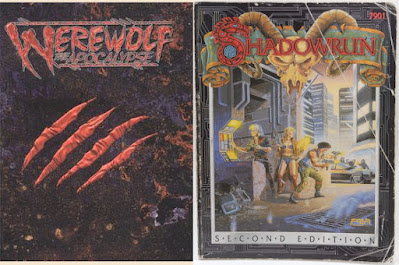I want to continue in the vein of some discourse that followed the death of Dragon Ball author Akira Toriyama. Toybox Creativity: The Genius of Dragon Ball talks about rejecting genre conventions by being open to combining disparate fantasy/sci-fi/other elements without worrying about explaining everything. Toy Box Naturalism builds on this idea by sprinkling in a little bit of Gygaxian Naturalism, which is the idea that a limited amount of backstory and ecology behind monsters makes them come alive and become more interesting in game. I really agree that explaining elements of your fantasy with more fantasy lore rather than technicalities can be a lot of fun.
I think my two 1992 "classics," Werewolf and Shadowrun, both demonstrate this ethic to create new fantasy worlds. They go about it very differently from each other but also have a lot in common. Both games frame campaigns that are politically charged, Shadowrun as corporate espionage lowlifes and Werewolf as... furry ecoterrorists. Both feel very '90s to me, both books are similar in size and pretty proportional in their levels of lore and rules crunch. Maybe Shadowrun has more crunch because of all the hacking rules and cyberware, but overall they feel close to me.
The lore that creates Shadowrun's fantasy universe feels a little like it is an ends to a means, like the goal was to figure out a way to combine the two genres. I do think the ebbing and waning of the Earths magical field is a very cool bit of world building, but the amount of effect it has is minimal aside from weaving fantasy into cyberpunk. The emergence of horrors with the growing magical field gives the setting a Lovecraftian, post-apocalyptic element, but our attention is drawn to the dense city centers for corporate intrigue.
Werewolf's lore leads in almost the opposite direction. It creates an acute genre, centered around secret werewolf societies that all work towards a mission aligned with their spiritual position in the universe. Part of this difference between the two games is because genre is such a broad term. Genre can describe the world your story takes place in, but it can also describe the characters in the story. The genre of detective stories, for example, its not about whole worlds full of detectives, its just features detectives. Werewolf makes use of this, where being a werewolf is not just something that you are, but an identity and worldview.
I have a world building game I play with some friends that started out as a way to choose which movie to watch from a shelf of VHS cassettes. Everyone pulls out one or a few cassettes a little bit out from the shelf, and then everyone takes turns pushing cassettes back into the shelf one at a time, until just one remains. The final remaining movie is the movie for the night. My friends and I use a similar approach for a world building exercise. Everyone writes a genre element on a notecard and puts them on the table, making and adding as many notecards as they want. Next, we all take turns removing cards until we are left with a handful of elements that we think we can work into a cool campaign framework.
Halfway through this game, you end up in a place that is sort of Toybox Creativity taken to its extreme. With every genre your group can think of thrown in the mix, it becomes a Kitchen Sink Fantasy, a fantasy where all possible fantasy elements exist, the collective product of your imaginations all together in one universe. The first half of the game up to here is freewheeling brainstorming. In the second half, you break the Kitchen Sink Fantasy down into increasingly specific combinations, things that you never thought of putting together become world-defining realities. This part is about being critical. We are making those tough decisions. What can we cut? What do we want to keep? This half is more serious in contrast to the light-heartedness of the first half.
So my point in all this, is that to me Shadowrun exists on the first half of this journey, optimistically brainstorming and adding to the pile. Werewolf exists on the second half of the journey, on the way back down toward an intentional aesthetic, brooding and paring away from Kitchen Sink Fantasy.
